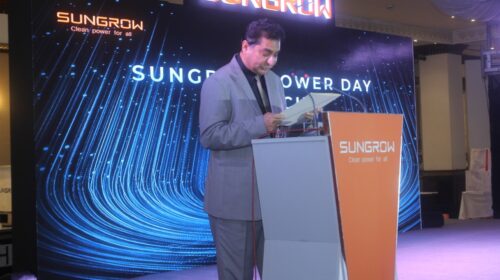The Sindh government with its aim to utilize massive solar energy potential of the province is working to unveil a policy to establish mini/micro grids to energies the off-grid villages at the most affordable cost in partnership with the private sector.
Sindh government’s Secretary for the Energy Department, Abu Bakar Madani, stated this while speaking as the chief guest at the Solar Power Day seminar organized by Sungrow Pakistan.
The Sindh Energy Secretary informed audience of the seminar that the provincial government had been working on a number of initiatives to tap indigenous renewable energy resources of the province with the aim to provide affordable energy to the people of Pakistan. These clean energy resources include wind, solar, biomass, small-scale hydropower, and waste-to-energy potential available in Sindh.
He said the Sindh Energy Department had launched the World Bank-funded Sindh Solar Energy Project envisaging a 400 MWs capacity solar park and provision of 200,000 solar home systems in ten districts of the province having low energy access. The same project is also being implemented to produce an additional 20 MWs of solar power through utilization of the rooftops of the public sector buildings in urban areas mainly the hospitals.
He told the audience that the Sindh government had already installed 352 solar PV hybrid systems in 225 primary health facilitates in 13 districts of Sindh. Moreover, 150 MWs (3×50 MWs) of upcoming on-grid solar PV power projects in Sindh has achieved the milestone of financial close.
The Energy Secretary said the Sindh government facilitated the private investors to invest in the alternative and renewable energy sector as for the purpose a “Land Grant Policy 2015” was being implemented for providing land to execute clean power projects.
“The Energy Department is fully dedicated to serve the nation, facilitating the private sector by providing one-window solutions and utilizing the indigenous resources of Sindh to not only produce electricity but also to reduce dependency on imported fuel for accelerating national economic growth,” he added.
CEO of Sindh Transmission and Dispatch Company (STDC), Saleem Shaikh, told the seminar that recently the STDC had signed a MoU to develop 400 MWs first-ever hybrid (wind/solar) renewable energy project in Pakistan on B2B model.
He said the STDC fully stood for the cause that immense solar power potential of Sindh should be utilised for overcoming the problem of electricity shortfall for every domestic consumer in the country.
He said the STDC had the desire to enter into similar more B2B arrangements to energise off-grid rural areas and industries of the province.
HESCO Director, Irfan Ahmed, said that Pakistan had to make much more efforts to take full advantage of the abundantly available solar energy resource in the country whose availability had been much more than many developed countries.
He said the solar energy was a distributed generation resource so the provincial government should solely do its management locally.
He said the export-oriented industries in the province would be more than willing to get supply of renewable electricity as per the requirements of their international clients.
Usman Waheed, Country Head of Sungrow Pakistan, said the seminar had been organised to celebrate successful installation of solar energy projects of total 850 MWs capacity all over the country by his renewable sector company.
He said the Sungrow had been facilitating installation of more solar power projects in Pakistan so to help production of over 1GW of clean electricity expected to achieve early next year.
He said the Sungrow had been present in Pakistan since 2013 and had worked with all the key stakeholders of the solar energy sector in the country.
He said that his company had the aim to promote usage of solar power all possible market segments form domestic to SME, C&I to Utility Scale.
Sungrow International Director, Howard Fu, said the solar energy products of his company had the lowest failure rate in the world as that was possible due to maximum utilization of financial and human resources for doing R&D activities to improve technology and standards for its customers.
Sungrow Power Day Seminar 2021 – Karachi Chapter





